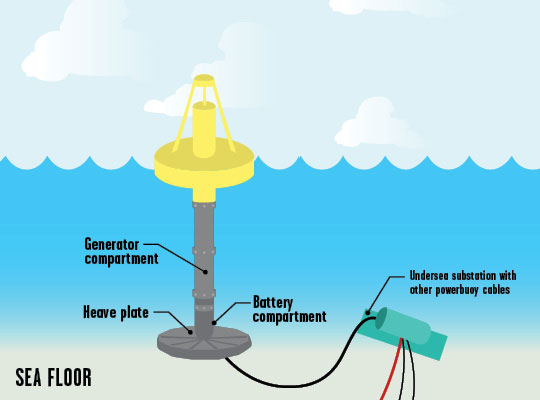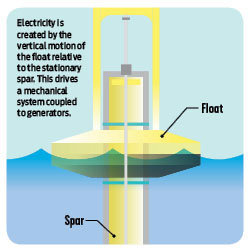If you’ve ever felt the earth shake from a crashing wave or come up a bit green after being tossed around on a boat, you have an idea of how powerful ocean waves and currents can be.
The founders of Pennington, N.J.-based Ocean Power Technologies (OPT) have developed technology to harness and convert wave energy into a clean, renewable power source. The mainstay of their technology, the PowerBuoy, is an offshore wave energy converter. The buoy sits mostly below the water’s surface and contains a piston-like structure that moves up and down with the waves. That movement drives a generator, producing electricity that is sent to shore by a cable.
Wave energy is more predictable than wind energy, and approximately 1,000 times more dense, meaning waves have the potential to generate much more energy than wind. And with an estimated 44 percent of the world’s population living within 93 miles of a coast, it is an energy source that exists largely where it is needed.
“This presents a compelling point because much of the [electricity] transmission and distribution infrastructure is already there,” says Charles Dunleavy, OPT’s chief executive officer. “This makes [wave energy] better than wind in that often wind energy requires that infrastructure be built to transmit it to where the population centers are.”
In September, the company was awarded $1 million by the U.S. Department of Energy (DOE) to fund design changes that will reduce overall capital costs, improve output and enhance the technology’s commercial viability. “[Support] from the U.S. Navy and DOE helps enhance the commercial viability of OPT’s PowerBuoy wave energy systems for both on-grid and autonomous wave energy generation systems,” says OPT vice president Debbie Montagna. “Funds from the DOE grant will also enable the company’s engineers to evaluate alternative designs for the PowerBuoy, optimizing the system’s geometry, materials used, power output, manufacturability, durability and handling, and thus, overall efficacy in harnessing the energy of the ocean’s waves.”
Dunleavy sees the grant as an important step in making the technology more available. “Getting to economies of scale will help bring the cost of wave energy down,” he says.
It may not be long before some of the energy powering your home is coming from the sea.
Learn more at oceanpowertechnologies.com.
Story by Courtney Sexton.








